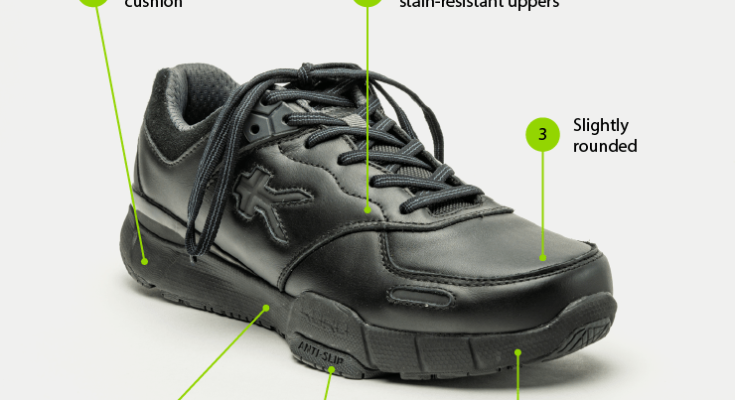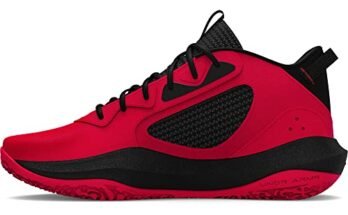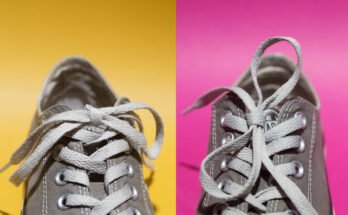To determine if shoes are non-slip, look for a “non-slip” or “slip-resistant” label on the sole. Additionally, check for deep treads and a rubber sole for better traction.
Ensuring that your shoes provide a non-slip grip is crucial for safety, especially in work environments where slippery floors are common. Slip-resistant shoes offer improved traction, reducing the risk of accidents and injuries. Whether you work in a restaurant, hospital, or any other place where slippery surfaces are a concern, investing in non-slip shoes can provide peace of mind and minimize the risk of falls.
By understanding the key features of non-slip shoes, you can make informed decisions to protect yourself and others from potential hazards.

Credit: www.wikihow.com
Factors To Consider
Slippery shoes can lead to serious accidents, especially in hazardous work environments. Therefore, it’s essential to choose non-slip shoes for your safety. But, how do you know if shoes are non-slip? There are several factors to consider before buying non-slip shoes.
Outsole Material
The outsole material of shoes is a crucial factor in determining their slip-resistance. Shoes with rubber outsoles are generally more slip-resistant than those with leather or plastic outsoles. Rubber is a high-friction material that provides excellent grip and traction on slippery surfaces. Additionally, shoes with deep treads on the outsole can also provide better slip-resistance. The deeper the treads, the better the grip.
Traction Pattern
The traction pattern on the outsole is another important factor to consider. Shoes with a multidirectional traction pattern are more slip-resistant than those with a unidirectional pattern. Multidirectional patterns provide better grip and traction on wet and oily surfaces, reducing the risk of slips and falls.
Certifications
When shopping for non-slip shoes, look for certifications that indicate their slip-resistance. One such certification is the ASTM F2913-11 standard, which measures the coefficient of friction of the outsole material. Shoes that meet or exceed this standard are considered slip-resistant. Additionally, shoes with a Mark II slip-resistant rating have been tested on oily and wet surfaces and are considered safe for use in such environments.
Conclusion
By considering the outsole material, traction pattern, and certifications, you can determine whether a shoe is non-slip or not. Investing in non-slip shoes can prevent accidents and injuries, ensuring your safety in hazardous work environments.
Testing Methods
When it comes to non-slip shoes, it’s crucial to ensure that they meet the necessary safety standards to provide reliable traction in slippery conditions. This is where testing methods play a vital role in determining the slip-resistant qualities of footwear. Various tests are conducted to evaluate the non-slip properties of shoes, providing consumers with the assurance of safety and stability.
Wet Surface Test
The wet surface test is a fundamental method used to assess the slip-resistant capabilities of shoes. It involves subjecting the footwear to a wet surface and analyzing its traction performance. This test simulates real-life scenarios where individuals encounter wet or moist surfaces, such as kitchen floors or outdoor walkways. Shoes that effectively grip the wet surface without slipping are deemed to have superior non-slip qualities.
Oil Resistance Test
The oil resistance test evaluates how well shoes maintain their slip-resistant properties in the presence of oils and greasy substances. Footwear is exposed to oil-coated surfaces to determine its ability to withstand slippery conditions caused by oil spillages. This test is particularly important for work environments like restaurants and industrial settings where oil spills are common. Shoes that exhibit high resistance to oil-induced slips are considered reliable in non-slip performance.
Slip-resistance Rating
Slip-resistance ratings provide consumers with a standardized measure of a shoe’s non-slip capabilities. These ratings are typically expressed as coefficients of friction, indicating the level of traction the footwear offers on various surfaces. By referring to these ratings, individuals can make informed decisions when selecting non-slip shoes, ensuring they choose footwear that meets their specific safety requirements.
Shoe Maintenance
Shoe maintenance is crucial to ensure that your non-slip shoes continue to provide the traction and safety you rely on. Proper care and regular inspections can help you determine if your shoes are still non-slip or if it’s time to consider replacing them. Let’s explore the essential aspects of shoe maintenance, including cleaning and care, as well as replacing worn outsoles.
Cleaning And Care
Regular cleaning and care are essential to maintain the non-slip properties of your shoes. Clean your shoes after each use, especially if they have been exposed to grease, oil, or other slippery substances. Use a mild soap and water to gently scrub the outsoles and remove any debris or contaminants that could compromise the traction.
Allow your shoes to air dry thoroughly after cleaning, and avoid exposing them to direct heat sources, as excessive heat can damage the outsoles and diminish their non-slip capabilities. Additionally, consider using a protective spray or coating specifically designed for non-slip shoes to enhance their resistance to slippery surfaces.
Replacing Worn Outsoles
Over time, the outsoles of non-slip shoes can wear down, reducing their effectiveness in providing traction. Regularly inspect the outsoles for signs of wear, such as smooth or uneven surfaces, shallow treads, or visible damage. If you notice significant wear or deterioration, it may be time to replace the outsoles or consider investing in a new pair of non-slip shoes.

Credit: www.vionicshoes.com
Footwear Regulations
Footwear regulations ensure shoes meet non-slip standards, crucial for safety in various industries. Look for ‘slip-resistant’ labels and patterns on the outsole to know if shoes are non-slip.
When it comes to safety in the workplace, it’s essential to ensure that your footwear is non-slip. Slippery floors can cause serious injuries, which is why there are footwear regulations in place to ensure that workers are protected. These regulations outline the requirements for non-slip footwear, which can vary depending on the industry and type of job.Occupational Safety Standards
Occupational safety standards are the guidelines set by regulatory bodies, such as OSHA, to ensure that workers are protected from workplace hazards. One of the requirements for occupational safety is non-slip footwear. Non-slip shoes must have a sole that provides sufficient traction on slippery surfaces. They should also have a closed heel and toe to protect the feet from injuries.Workplace Requirements
In addition to occupational safety standards, many workplaces have their own requirements for non-slip footwear. Employers may require specific types of shoes for their employees, depending on the nature of the job. For example, workers in the food service industry may need shoes that are waterproof and slip-resistant to prevent slips and falls in the kitchen. To ensure that your shoes meet workplace requirements, it’s essential to consult with your employer or HR department. They can provide you with the necessary information and guidelines for footwear that meets the safety standards of your industry.In Conclusion
In conclusion, non-slip footwear is essential for workplace safety, and adherence to footwear regulations is crucial. By following occupational safety standards and workplace requirements, you can ensure that your shoes are slip-resistant and provide adequate protection for your feet. Remember to consult with your employer or HR department to ensure that your shoes meet the necessary safety standards.Choosing The Right Shoes
Ensuring your shoes are non-slip is crucial for safety in various environments. When selecting the right shoes, consider your work environment and personal comfort.
Work Environment Considerations
Assess the type of surface you will be walking on – is it wet, oily, or slippery? Look for shoes with proper grip patterns and slip-resistant soles for added stability.
Personal Comfort And Fit
Choose shoes that provide adequate support and cushioning to prevent foot fatigue. Ensure a proper fit to avoid discomfort or potential injuries during long shifts.

Credit: vionicshoes.ca
Brands And Models
When it comes to non-slip shoes, finding the right brands and models can be crucial in ensuring safety and comfort in the workplace. With a wide variety of options available, it’s important to consider the top non-slip shoe brands and popular models that have been designed to provide the necessary traction and support.
Top Non-slip Shoe Brands
Several renowned brands have made a name for themselves in the non-slip shoe market, consistently delivering reliable and high-quality footwear. These brands prioritize safety and functionality without compromising on style and comfort. Some of the top non-slip shoe brands include:
- Shoe Brand 1: Known for its durable construction and exceptional grip, this brand offers a range of non-slip shoes suitable for various professions.
- Shoe Brand 2: With a focus on innovative design and advanced slip-resistant technology, this brand has become a popular choice among workers in demanding environments.
- Shoe Brand 3: This brand has gained recognition for its commitment to creating non-slip footwear that meets rigorous safety standards while ensuring maximum comfort for long hours on your feet.
Popular Non-slip Shoe Models
Within each brand, there are specific models that stand out for their superior non-slip features and overall performance. These popular non-slip shoe models have garnered positive feedback from users across various industries:
- Shoe Model 1: Equipped with advanced tread patterns and cushioned support, this model is ideal for professionals who require reliable non-slip footwear.
- Shoe Model 2: Featuring a lightweight yet durable design, this model offers exceptional traction and stability, making it a top choice for workers in fast-paced environments.
- Shoe Model 3: Known for its water-resistant properties and anti-slip outsole, this model provides excellent grip on wet and slippery surfaces, catering to the needs of various occupations.
Frequently Asked Questions
How Do I Tell If My Shoe Is Non-slip?
Check the outsole for a tread pattern with deep grooves and a “non-slip” or “anti-slip” label. Additionally, look for a high coefficient of friction or ASTM F2913-11 certification.
How Do I Make Sure My Shoes Don’t Slip?
To prevent shoes from slipping, try using non-slip pads or grip-enhancing products. Ensure proper shoe fit and consider adding friction with rough surfaces. Regularly clean shoe soles to maintain traction. Lastly, be cautious on smooth or wet surfaces to avoid slipping.
Does Rubber Sole Mean Slip Resistant?
Rubber soles don’t always mean slip-resistant. Look for specific slip-resistant features when buying shoes.
What Does Non-slip Sole Look Like?
A non-slip sole typically features a textured pattern or grooves that increase traction on surfaces. It helps prevent slipping.
Conclusion
In a nutshell, ensuring your shoes are non-slip is crucial for safety. By understanding the key features and testing methods, you can confidently choose the right footwear. Prioritize traction, material, and certifications to stay slip-free in various environments. Keep these factors in mind for slip-resistant and secure footwear selections.



